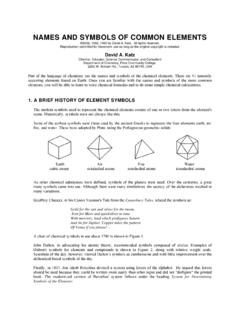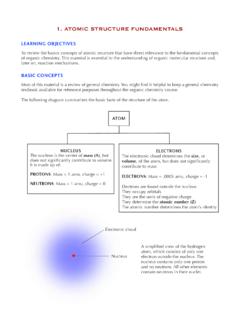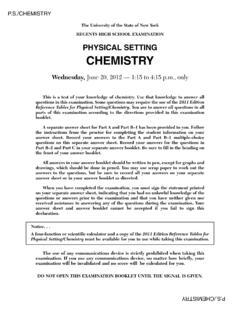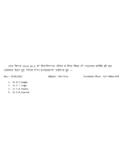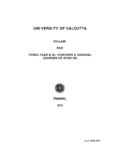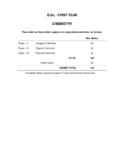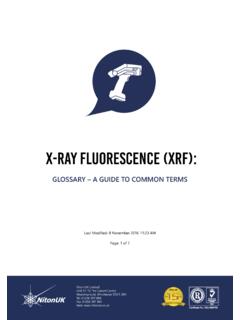Transcription of Candidate Style Answer - OCR
1 OCR GCE chemistry A F321 Candidate Style answers (High) 1 Candidate Style Answer chemistry A Unit F321 Atoms, Bonds and Groups High banded response This Support Material booklet is designed to accompany the OCR GCE chemistry A Specimen Paper F321 for teaching from September 2008. OCR GCE chemistry A F321 Candidate Style answers (High) 2 Contents Contents 2 Introduction 3 Candidate Style Answer 4 Question 1 (a) 4 Comments 4 Question 1 (b)
2 5 Comments 5 Question 1 (c) 5 Comments 6 Question 2 (a) 6 Comments 7 Question 2 (b) 7 Comments 8 Question 3 (a) 8 Comments 8 Question 3 (b) 8 Comments 9 Question 3 (c)
3 9 Comments 10 Question 4 (a) 10 Comments 10 Question 4 (b) 11 Comments 11 Question 4 (c) 11 Comments 12 Question 5 (a) 12 Comments 12 Question 5 (b)
4 13 Comments 13 Overall Comments 13 OCR GCE chemistry A F321 Candidate Style answers (High) 3 Introduction OCR has produced these Candidate Style answers to support teachers in interpreting the assessment criteria for the new GCE specifications and to bridge the gap between new specification release and availability of exemplar Candidate work.
5 This content has been produced by senior OCR examiners, with the input of Chairs of Examiners, to illustrate how the sample assessment questions might be answered and provide some commentary on what factors contribute to an overall grading. The Candidate Style answers are not written in a way that is intended to replicate student work but to demonstrate what a good or excellent response might include, supported by examiner commentary and conclusions. As these responses have not been through full moderation and do not replicate student work, they have not been graded and are instead, banded medium or high to give an indication of the level of each response.
6 Please note that this resource is provided for advice and guidance only and does not in any way constitute an indication of grade boundaries or endorsed answers . OCR GCE chemistry A F321 Candidate Style answers (High) 4 Unit F321 Atoms, Bonds and Groups High banded response Question 1 (a) 1 The Group 7 element bromine was discovered by Balard in 1826. Bromine gets its name from the Greek bromos meaning stench. (a) Bromine consists of a mixture of two isotopes, 79Br and 81Br.
7 (i) What is meant by the term isotopes? [1] Atoms of the same element with a different number of neutrons (ii) Complete the table below to show the atomic structures of the bromine isotopes. [2] protons neutrons electrons 79Br 35 44 35 81Br 35 46 35 (iii) Write the full electronic configuration of a bromine atom. [1] 1s2 2s2 2p6 3s2 3p6 3d10 4s2 4p5 Comments This is all correct.
8 The definition of isotopes is a text book definition, the particles are all correct and the electronic structure, although a more difficult example, is also correct. OCR GCE chemistry A F321 Candidate Style answers (High) 5 Question 1 (b) (b) A student added an aqueous solution of sodium iodide to a solution of bromine. The colour turned from orange to a deep brown. The student then added an aqueous solution of sodium chloride to a solution of bromine. The orange colour was unchanged. (i) Explain these observations.
9 [3] In your Answer , you should use appropriate technical terms, spelled correctly. In the first experiment iodide ions were reduced to iodine because bromine is more reactive than iodine. A displacement reaction has taken place. In the second experiment bromine could not displace chlorine because chlorine is more reactive than bromine, so no reaction takes place. (ii) Write an ionic equation for the reaction that has taken place. [1] I2 + Br- Br2 + I- Comments The response in part (i) covers all three marking points.
10 The technical terms, iodide and iodine have also been used and spelled correctly. In (ii), the species have all been identified correctly, but the Candidate has apparently forgotten the comparatively easy step of balancing the equation. Question 1 (c) (c) A student read about possible health problems arising from the use of common salt added to different foods. The student decided to compare the salt content of different foods using simple test-tube tests to test the chloride content. Plan a simple qualitative experiment to compare the quantity of chloride ions in different foods.










